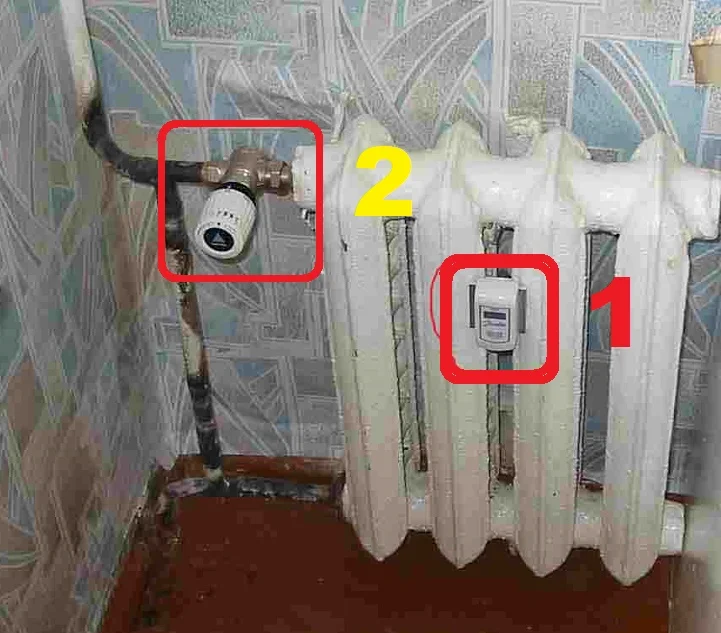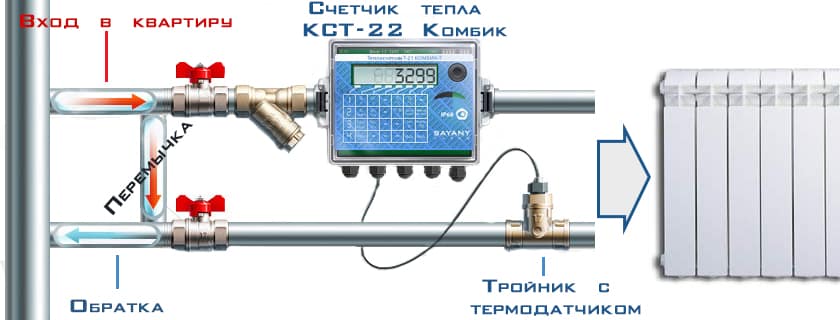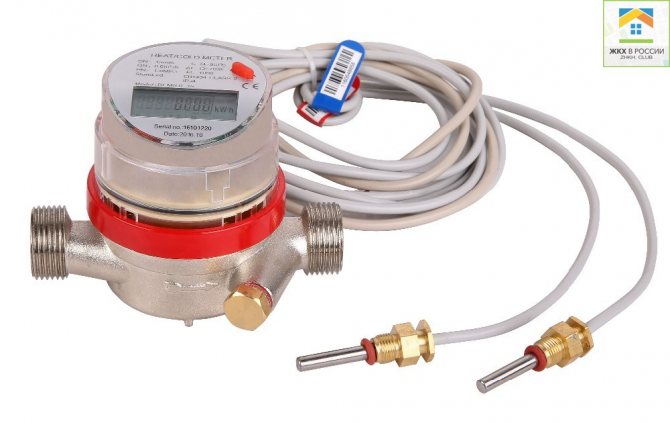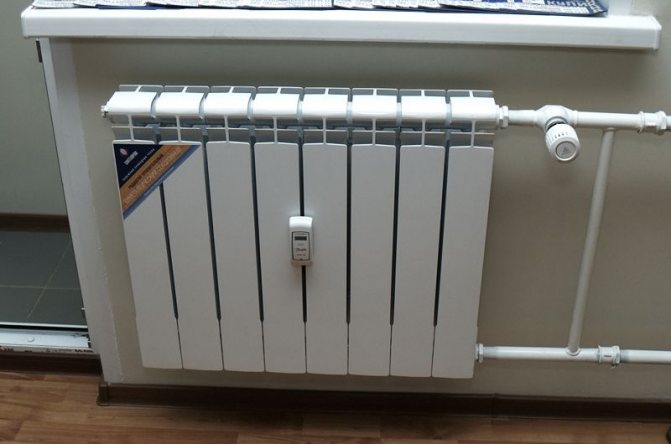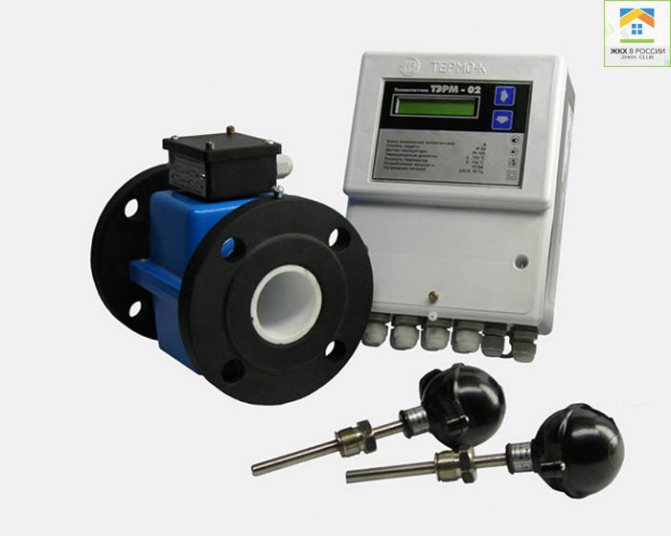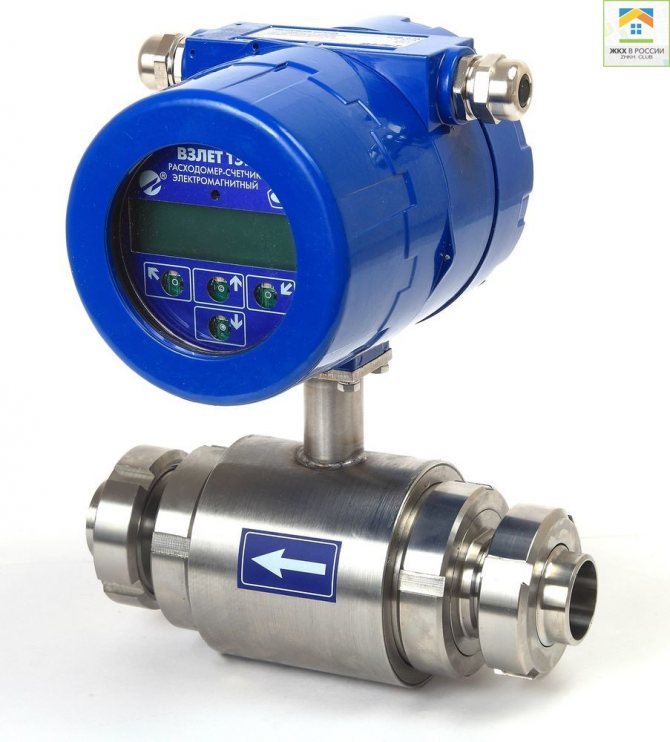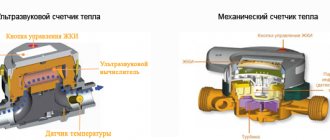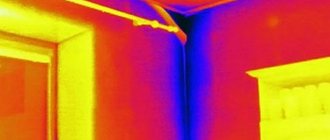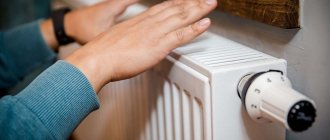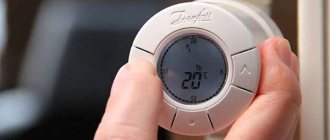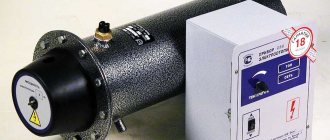Why do you need a counter?
The most serious expense item today is energy. In a private house, the owner solves the problem of saving on his own, and in a city apartment building, everything is often left to chance. Meanwhile, you can also spend less on heating (as well as on electricity and water supply) in the city - if you pay only your own expenses, and not some average indicator. Any modern heating device can be equipped with a thermostat and increase / decrease the temperature depending on the needs of the family.
A common meter should be installed so as not to pay for heat that did not enter the building in principle. It is expensive, it is bought by the tenants at the same time.
It is possible to install meters for heating in an apartment or not, depends on the type of wiring in the house. Buildings in recent years provide for horizontal wiring: hot water is supplied to each apartment by one riser, from which it diverges to heating devices.
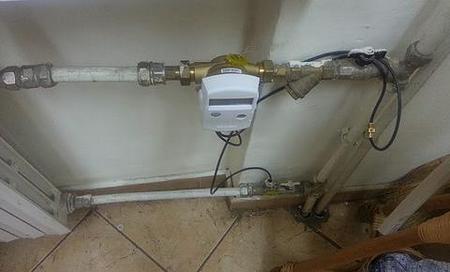
Heat meter in the apartment
A different picture in the houses of the old buildings (Khrushchev, etc.). Here, the riser serves one vertical row of batteries on all floors. There are as many risers as there are radiators in the apartment. In this case, it would be necessary to install a metering device for each battery separately, which is unprofitable and greatly complicates accounting.
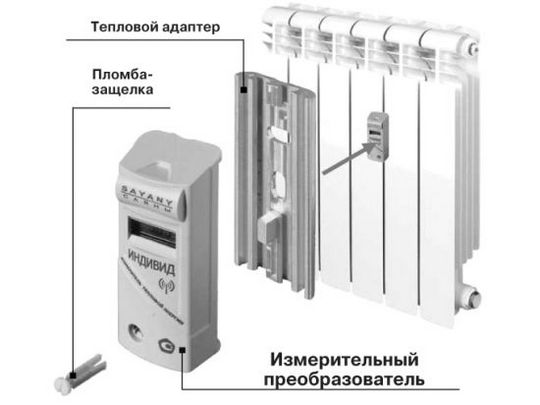

If it is impossible to install a heat meter, you can use a heat distributor
In buildings with vertical wiring, the installation of individual heat meters is not carried out (according to the Order of the Ministry of Regional Development of the Russian Federation 627 of December 29, 2011). In such a situation, a distributor can be installed in the system, which determines the flow rate by the temperature difference between the air in the room and the surface of the radiator.
Important: There is a clause in the legislative documents that may complicate your transition to payment by an individual meter. In accordance with the RF PP 354 (42-1), if not all apartments in the house are equipped with individual metering devices, the service provider has the right to charge a fee based on the readings of the general house meter in terms of the area of each apartment. Sometimes you have to put the question to the vote of the residents of the house.
Principle of operation
Warm floors through heating. Hot water floor as the main heating
This device is designed to account for the heat that enters the apartment from the CHP. Its principle of operation is based on combining the functions of a water meter and a thermometer. The water meter of the device reads the flow rate of water entering the heating system of the apartment, and the temperature sensor records the temperature of the water entering and leaving the heating pipeline. The data from the flow meter and temperature sensors are sent to the computing device of the device, which converts them into heat units - hectacalories. Moreover, such a device is capable of storing information on the amount of consumed heat both in one day and in a month or even a year.
Many heat meters are installed on the heating system together with a regulating electric valve, which makes it possible to control the amount of heat entering the apartment. This is very convenient, since a high temperature in radiators is not always needed, and with the help of this tap, you can regulate the flow of hot water into the heating system.
For example, if all family members are outside the house during the day, then why heat up an empty apartment too much? You can simply program that this valve allows the minimum flow during the day, and in the evening, before the arrival of the household, it opens to full and warms up the apartment. Or, for example, if the temperature in the apartment is higher than necessary, you can also limit it using this device.
The choice of metering device
By designation, heating meters are divided into industrial (they are also used as general house) and individual (apartment).
The apartment unit has small channels (within 2 centimeters). The measurement range of the coolant flow is from 0.6 to 2.5 cubic meters per hour. The package most often includes:
- heat sensor;
- the actual counter with the calculator;
- regulators of pressure, flow rate, resistance (optional).
A calculator is installed on the meter, two wires with sensors are connected - one to the supply pipe, the other to the outlet. The amount of consumed heat is determined by the temperature difference between them.
The general house appliance differs from the apartment appliance mainly in size: the channel diameter is from 2.5 to 30 cm.


Mechanical heat meter Pulsar
According to the characteristics of the device, the devices are divided into ultrasonic and mechanical (tachometric). There are also vortex and electromagnetic heating meters, but they are less common for individual use.
The mechanical design includes a calculator and a rotary water meter. The working body is an impeller (screw), which rotates under the action of a passing coolant. The amount of heat is determined by the number of rotations.
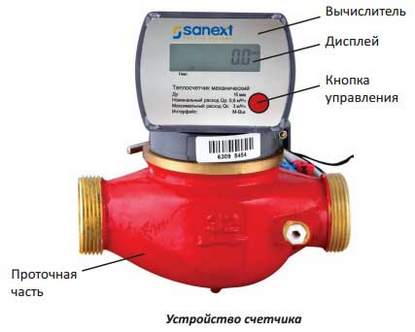

Mechanical meter design for heating
The device is relatively inexpensive. With a pipeline diameter of up to 3.2 cm, the purchase will cost 15 percent less than an ultrasonic meter. Repair is also inexpensive.
The disadvantages include vulnerability to hard water with rust or scale: particles clog flow meters and filters, which reduces the resource. It is obligatory to install a magnetic mesh filter for coarse water purification. But even in this case, the operating time does not exceed 5 years.
The main working body of an ultrasonic heat meter is a pair of devices: an emitter and a receiver of ultrasonic signals. Signals are transmitted through the stream of water. The transmission time depends on the flow rate: the speed is calculated from the time and, accordingly, the flow rate.
Pros of the u / s counter:
- the accuracy of the readings is higher than that of the mechanical one. Accordingly, the calculation of heating by the meter in an apartment building for these models is more correct;
- longer working life (service life 10 years).


Ultrasonic heat meter
The ultrasonic device itself is less sensitive to water quality than a mechanical one, but the correctness of the readings depends on the purity of the coolant. Accuracy is affected by dirt and air bubbles. To avoid the appearance of bubbles, the meter is installed strictly on a straight section of the line (not shorter than 1 meter).
Advice: It is recommended to choose a heat meter model with an autonomous power source. Then the operation of the device will not stop in the event of a power outage.
Installation
The figure shows a variant of installing a heat meter in a heating system.
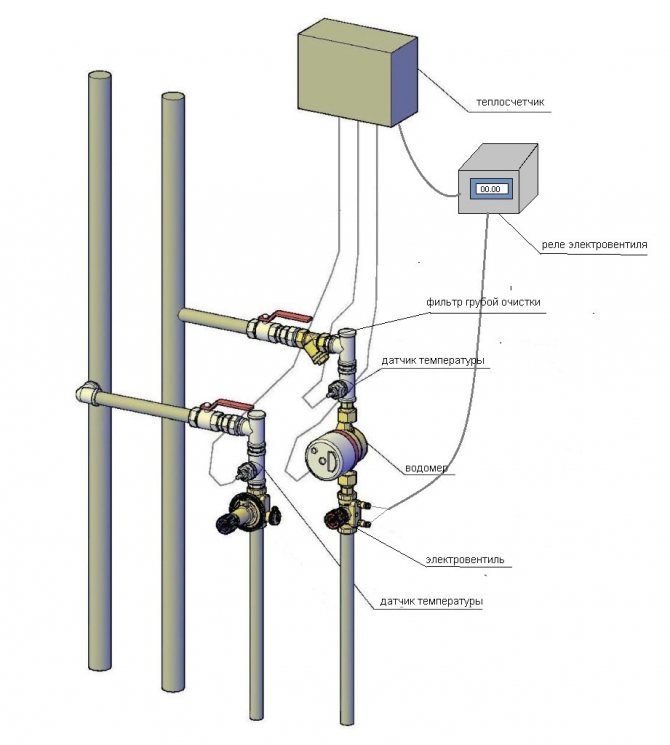

Installation diagram of a heat meter in the heating system
As you can see from the figure, the heat meter consists of several parts:
- Flow meter - used to account for hot water that enters the system. Data in the form of electronic signals are sent to the metering and control unit of the heat meter.
- Temperature sensors - installed on the supply and return pipes of the heating. The data from the sensors are also fed to the heat meter.
- Accounting and control unit - this unit receives all data from temperature sensors and a flow meter. Based on these data, the built-in microprocessor calculates the amount of heat consumed in Gcal.
- The electric valve control relay is a device for regulating the heat supplied to the apartment.The electric valve is installed on the supply pipe, and the control relay is installed nearby and connected by wires to the electric valve.
To install the flow meter and sensors with your own hands, you first need to agree with the management of housing and communal services about turning off the heating in the apartment during installation. You also need to find on the pipes that go from the riser, a threaded connection, from which the installation of the heat meter will begin. If this is not the case, then you will have to do it yourself.
To do this, you can go in two ways: since usually metal pipes are installed in heating systems, you need to either cut a thread on these pipes, or weld two threaded squeegees. If the pipeline is plastic, then using a soldering iron, threaded transitions are installed. These threaded outlets are fitted with two conventional semi-turn valves.
After the shut-off valves are installed, the heating can be reconnected. It is better to do this as soon as possible, because in order to change the heat meter in one apartment, housing and communal services have to turn off several apartments at once, and if this happens during the heating season, then leaving the neighbors without heating is not the best solution.
After the shut-off valve, a coarse filter is installed on the threaded connection. This must be done in order to exclude the ingress of various suspended particles from the line into the water meter. As you can see from the figure, then a temperature sensor is installed on the thread, and after it, a water meter. After the water meter - an electric valve. Only a temperature sensor and a balancing valve are installed on the return pipe.
After installing the heat meter and turning on the heating, inspect the threaded connections for possible leaks, and, if necessary, eliminate them. Then you need to bleed air from the heating batteries.
In order to start using the meter, you need to call a representative of the housing and communal services. He will seal it and draw up an act of acceptance into operation. After that, a corresponding book is issued to pay for services, you can start operating the heat meter.
In order to deal with the installation of a heat meter, you need, in addition to money for the purchase, free time. Therefore, if it is not there, you can entrust this work to an appropriate organization. It will cost a little more, but they will resolve all issues with housing and communal services, and with the design organization, and with installers.
Installing a heat meter
The decision to install a general house meter is made at a general meeting of residents, and is officially documented. Based on the minutes of the meeting, an application is submitted to the housing management company. From among the tenants, a person is selected who is responsible for taking and transmitting testimony.
How to put an individual meter for heating in an apartment:
- Make sure the installation is possible. The ideal option, in which you will not have any questions, is an examination report and a conclusion from a professional certified company.
- Before installing a meter for heating in an apartment, eliminate heat leaks through poorly fitted doors, window frames, freezing corners, leaky facade seams, etc. Otherwise, you will not be able to save money at the expense of your own device. Quite the opposite, since a lot of energy will be spent on heating the street.
- Get an opinion on the technical conditions of the installation (what is needed for installation) from your housing department. To do this, you must submit an application, attach a copy of the document on the ownership of housing and the registration certificate of the apartment to the application.
- Call a specialist from a certified installer, draw up an installation project.
- Agree on the project with your management company.
- After obtaining permission to install, you can buy a meter.The seller is obliged to provide you with all accompanying documentation: device passport, quality certificate, cash register and sales receipt.
- Call the installer. He will carry out the installation, test and start the device.
- Sealing is carried out by a commission consisting of a specialist from the installer, a representative of the housing office and the owner of the apartment.


Heating meter installation
What to look for when choosing an installer:
- in the Unified State Register of Legal Entities there must be information about it;
- the company has a certificate and SRO admission;
- it has the necessary specialists and equipment at its disposal;
- the ability to call a specialist to draw up a project;
- providing the client with a guarantee for the installation.
The project must indicate:
- calculation of the flow rate of the coolant;
- recommended device model;
- calculation of hydraulic resistance;
- installation diagram in the pipeline;
- calculation of unaccounted heat losses;
- scheme for calculating payments by the counter.
The installation of heating meters in an apartment building is subject to certain rules:
- the device is assembled exactly according to the project. If changes are made, the project is approved again;
- a typical installation scheme is outside the apartment. Installation in the apartment is agreed on an individual basis;
- when installing a heat meter on both sides of the flow meters, straight “calming” pipe sections are left. Thermal resistance should be on the pipe axis, possible "pockets" and air bubbles should be excluded;
- it is necessary to install a bypass bypassing the meter so that the device can be removed without draining the water from the system.
Mechanical type


It is a meter with a unified design. It can be screw, turbine or vane. The basis of the unit's operation lies in converting the translational movement of the coolant into the movement of the element for measurement.
This is the most affordable device in terms of cost. It cannot be used if water with increased hardness acts as a heat carrier, or if it contains rust particles, scale or scale. They can clog the mechanical parts of the device. Therefore, before installing the units, special filter systems are installed. In addition, the mechanical configuration does not tolerate sudden flow fluctuations.
We offer you to familiarize yourself with Sticking a tile with your own hands
Verification and taking readings
All measuring devices need regular verification - this way the serviceability of the meter is verified and, accordingly, the correctness of the tenant's transmission of flow readings.
Initial verification is carried out at the manufacturer. It is evidenced by a sticker or a stamp on the heat meter itself and an entry in the accompanying documents.
In the future, verification should be performed every four years at the expense of the apartment owner. To conduct it, you need to contact:
- to a company licensed to provide such services;
- to the service center of the meter manufacturer;
- to the local branch of Rostest.
They take readings in the same way as with other meters - electric, water. The difference between the readings for the current and last month is the actual expense, which must be multiplied by the tariff rate in order to calculate the amount to be paid.
The meter can determine the consumption in kilowatts, and it is required to transmit the readings in gigacalories. To convert watts to calories, the removed figure is multiplied by 0.0008598.
How to install a heat meter in an apartment
The easiest way is to install an overhead device, for this you do not need to hire anyone or cut pipes. It is enough to attach it to the battery. Mechanical heat meters are another matter, here you will have to shut off the risers, drain the water and dismantle the pipe section. The same applies to ultrasonic devices that are cut directly into the pipeline. As mentioned above, to carry out such work, you must have a permit and a finished project on hand.And for successful commissioning, the installation must be carried out by a licensed company, which will be confirmed by the corresponding act of work performed.
In the event that you decide to get to work on your own, first carefully study the instructions for the heat meter. There are given recommendations for installation and operation, which must be strictly observed. By the way, for tachometric and ultrasonic devices it is necessary to provide a measuring section of a certain length. That is, before and after the apparatus there should be a straight pipe without turns and bends.
For reference. The length of the measuring section for a mechanical meter is 3 pipe diameters before the flow meter and 1 diameter after it. The requirements for ultrasonic flow meters are higher, there, before the meter, a straight section of at least 5 diameters is needed and 3 - after (depending on the manufacturer).
Now about whether it is possible to put an apartment heat meter on the return pipe. Most manufacturers offer models that are installed on any line, the main thing is to correctly install resistance thermocouples (temperature sensors). Usually they are screwed into a tee or a special tap, which has a separate branch pipe for this purpose.
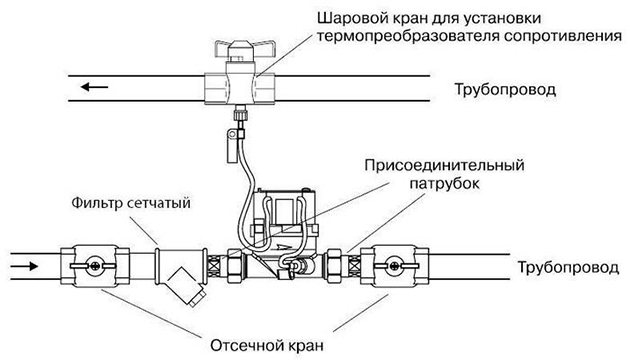

Is installation in an apartment building profitable?
If you managed to complete all the above points and you have a heating meter installed, then you will immediately have the following list of advantages:
- You will only pay for the heat that you used for a certain period, that is, according to the meter.
- If you have a time when you do not need heating, then you can save on it. That is, do not use the meter, heat, then do not pay.
- If your house or apartment also has insulated walls, floor and ceiling, then you will have to pay even less! You do not have to spend so much heating, since your apartment is already insulated from all sides.
As for the question of the payback of this device, then almost everything will depend on how you will operate it. But we can say for sure that you can save on it and very well.
More specifically, you can save about 20-30%. But if you are in doubt now, then you can safely look through the receipts of last year and compare them with those that will come after the installation of the meter. You will notice a decent difference right away!

